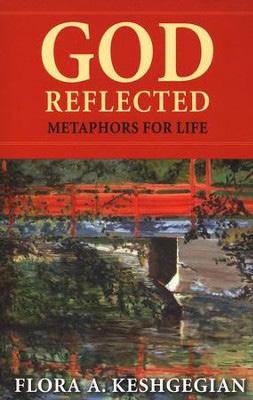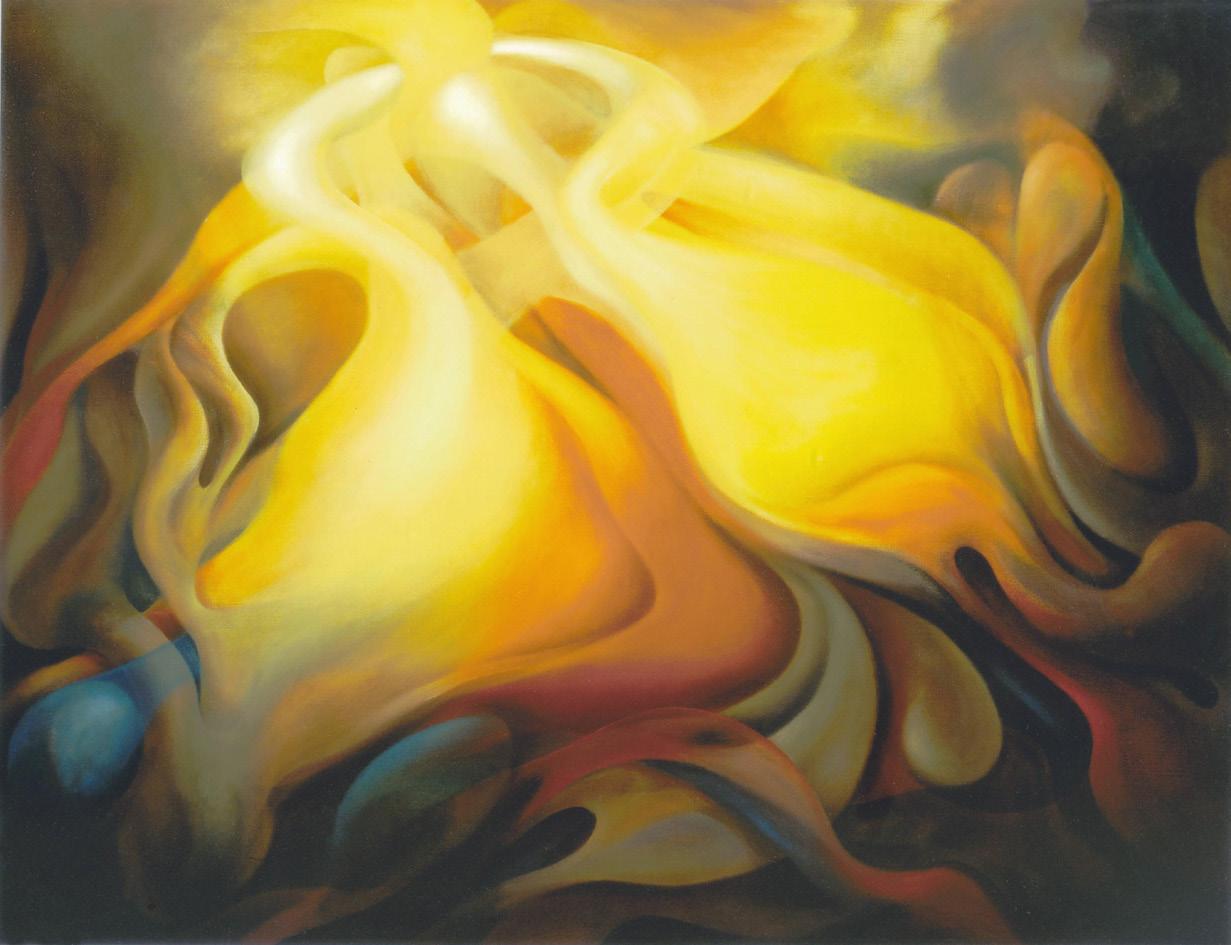
7 minute read
INCARNATION: A Reflection on Our Shared, Evolving Understanding
By Terri MacKenzie, SHCJ
RE-SOURCE: Session #1 — February 2, 2023
Because of our on-going efforts to deepen our understanding of Incarnation, the metaphors we choose and translations of relevant words are of great interest to me.
For example, “heaven” in Aramaic is not a place, but the image of ‘light and sound shining through all creation.’” (Neil Douglas-Klotz, The Our Father in Aramaic). Picture Our Father there!
Consider “And the Word became flesh.” According to Elizabeth Johnson, the Hebrew “sarx” (flesh) applies to more than Jesus, more than humans, and includes all matter. It “encompass[es] the whole biological world and the cosmic dust of which they are composed.”
. . . Perhaps you have experienced this sacred Wholeness . . .
Perhaps you have experienced this sacred Wholeness, this awareness that you are part of a divine-infused universal unity. Although the experience is beyond words, we seek them. Thich Nhat Han calls it the “web of interbeing” and Karen Barad suggests “intra-action”: “a continual process of emergence, in which nothing is certain or fixed, but is always becoming itself through its intra-action with everything else.” (See Teilhard de Chardin, Thomas Berry, Thomas Merton, Richard Rohr, Ilia Delio and many others.)
Of all the metaphors and phrases that have traveled through times, cultures and worldviews to name the nameless Mystery, most often we use “God.” When I read Brian Swimme’s The Universe Is a Green Dragon, I was disappointed that he had not used that word. I mentioned this to a friend who replied, “but the whole book is about God!” I needed three letters because, sadly, I had confused metaphor with reality.
The SHCJ’s 1986 general chapter, recognizing the hazards of overusing metaphors, especially masculine ones, called us to promote multiple images of God. The 1992 general chapter asked that the constitutions be written in inclusive language. The introduction to the 1994 Inclusive Language Version concludes with these words: “we encourage thinking and dialog about this important expression of our shared vision.”
This need of our time is highlighted by Irish theologian Dermot Lane in Theology and Ecology in Dialogue: The Wisdom of Laudato Si’.’ (Messenger Publications 2020) —
“The intellectual credibility — even the survival — of all religious traditions depends now on how convincingly they adapt their beliefs and aspirations to a scientifically understood universe whose special extension, temporal scale, and creative unfolding were unknown to religion’s founders and main teachers.”
Rooted in our rich history, I believe shared, evolving understanding of Incarnation can contribute to that survival!
See next page for a recommended reading g g g g g g g g g g g g
Book recommendation by Terri MacKenzie, SHCJ February 2023
God Reflected: Metaphors for Life

Flora A. Keshgegian, Fortress Press, 2008
As we explore our growth in understanding Incarnation, a book devoted to metaphors for God might be helpful. The beginning of this 184-page primer, written by a woman theologian and Episcopal priest, discusses “God’s will,” metaphors, and truth. Seven different metaphors each merit a chapter that includes scriptural and cultural backgrounds, ramifications, strengths and limitations. The epilogue explores discernment, cultural context, prayer and action, and power. The book includes Notes, Index, and suggestions for further reading.
A sample from the second chapter:
“Historically and still today theologians have tended to perceive God’s transcendence and immanence as opposed or in tension. …usually, in the end, these theologians put more value on transcendence.
As a result, Christianity, the religion that claims God became incarnate in the person of Jesus, that God was present in human flesh, has remained wary of the immanence implied by incarnation. This is one of the ironies of Christian theology….
Another traditional theological affirmation is that God, the divine, is mystery. … To say that God is mystery is to acknowledge that God is in some sense unknowable or that we cannot fully know God.
Yet, at the same time, the term communicates our desire for God, to know and be known. Mystery draws us in. What is unknown is alluring, even if somewhat unsettling. God as mystery attracts….”
How the author describes this book — https://www.florak.org/_i__god_reflected__metaphors_for_life__i__94502.htm
People often search for God's will for their lives, especially when faced with a decision, tragedy, or death. But what is meant by God's will? How does God act? How do they imagine the person and character God? This book surveys a variety of images for God, drawn from the Christian tradition and set within cultural contexts, including God as lord and master, as patriarch, as merciful father, as nurturing parent, as one who suffers with us, as one in relation, as energy for life. These are all metaphors that tell us important things about God, but do not define or confine who God is. As the chapters move through the metaphors, God's will is less about controlling action and more about encouraging life for all. Ultimately, the book redefines power, God's power and ours. "God Reflected" is helpful for those looking for new ways to imagine God and to find answers for questions about God's presence in their lives.
in Flesh” (Matthew 17: 1-9) by Sarah Bachelard
RE-SOURCE #1 — February 2 – May 27, 2023
Sarah Bachelard is a theologian and the leader of the Benedictine Contemplative Church, an ecumenical christian community, functioning both online, and from its base in Lyneham ACT, Australia (a suburb of Canberra in Australian Capitol Territory). She offered this reflection on February 23rd when the gospel story of the transfiguration of Jesus was featured in her Church’s liturgical calendar. For Catholics and many other Christians, this is the gospel for the second Sunday of Lent.
In this reflection, Bachelard draws on two contemporary writings —The Difference Jesus Makes by James Alison and Temple Theology: An Introduction by Margaret Barker — to offer fresh insights into the deep meaning of Jesus’ transfiguration, which leads us ultimately to the deep meaning of incarnation — to make the invisible God visible. The title of her reflection, “Veiled in Flesh,” is taken from the second verse of the Christmas hymn, “Hark the Herald Angels Sing:”
Veiled in flesh the Godhead see, Hail th’ incarnate Deity!
Pleased as man with man to dwell, Jesus our Immanuel.
Some excerpts are printed below.
Click here to read the full reflection https://benedictus.com.au/wp-content/uploads/2023/02/Veiled-in-Flesh-180223.pdf
To listen to a recording of it, click here https://benedictus.com.au/wp-content/uploads/2023/02/Audio-180223.mp3
“It’s often noted that the story of Transfiguration is symbol rich …. But there’s a further dimension to this dense layering of meaning I’ve discovered recently that I find powerful and important ….”
“[T]he First Temple in ancient Israel … built by Solomon, [was] destroyed in 587 BCE and replicated in the Second Temple which was known by Jesus and his disciples.1 [Inside the Temple, the Holy of Holies] was surrounded by a veil, so … it’s easy for us to assume ‘the Temple was a place into which … people went in order to offer sacrifice to God, who dwelt mysteriously and invisibly at the centre of it all’.2 [But] what’s actually signified is a movement that goes the other way. The Temple is not, in the first instance, about us moving towards God, but about God moving towards us.
[The major feast of the Temple in Jesus’ time was the Rite of Atonement when] “once a year the Lord would emerge from the Holy of Holies, come through the Veil into the created order, so as to offer sacrifice on our behalf. And note, this was not a human sacrifice to placate an angry God; it was God coming into the world so as to restore the harmony of creation, the relationships that had gotten snarled up in the course of the year.” [Ritually, it was the role of the High Priest to represent God for the day]
“dressed in white; he went into the Holy Place (beyond sight of those watching), and then came out again (having so communed in prayer with God that he has become ‘one’ with God), his white robe brilliant against the rich, multi-coloured fabric of the Temple Veil ….
There seems an obvious echo of this rite of Atonement in the gospel’s account of the Transfiguration, and it helps interpret what’s coming next. Jesus is depicted as the High Priest, though he is not just symbolically but truly one with God. He communes with God in the space beyond creation and comes out into the world (dressed in dazzling white) so as to reconnect creation to its foundation and fullness. At the Transfiguration, the disciples have a vision of God, in the person of Jesus, coming towards us to make us one.

[Another] feature of the Temple rite was that after the High Priest emerged from the Holy of Holies in his white robe, the other priests straight away covered him with a second garment. This was made of exactly the same multi-coloured material as the Temple Veil with one small difference. It was shot through with gold filament, indicating that the one wearing it has come through from ‘the other side’. God, who is in principle invisible, can now be seen ….
And it seems to me there’s something here in this image of a human being clothed in the ordinary fabric of the world, yet with the garment shot through with gold filament that is a profound resource. For me, it offers a way of imagining what matters about our faithfulness to prayer and worship, as well as to the tasks and difficulties of our daily life. How else can the invisible God become visible, the immaterial become material, the unsayable name become sayable, except as it is borne and translated by actions, lives and words that are open to the reality beyond while faithful to the here and now. ‘Veiled in flesh, the Godhead see’ proclaims the Christmas hymn. This is the meaning of Jesus’ incarnation; it’s what the disciples realise at the Transfiguration; and now it’s our vocation too.”
1 James Alison, Jesus the Forgiving Victim: Listening for the Unheard Voice, Book Three: The Difference Jesus Makes (Glenview, IL: Doers Publlishing, 2013), p.235. In what follows, I draw extensively on Alison’s account. See also Margaret Barker, Temple Theology: An Introduction (London: SPCK, 2004).
2 Alison, The Difference Jesus Makes, p.239.







